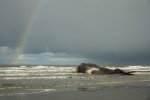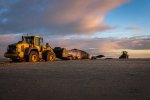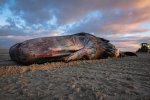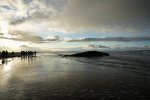
News
Vlieland sperm whale under the microscope
It was a bit of a wait, but when a group of seven sperm whales stranded in England on Christmas Eve, the Dutch also went to red alert. There was a good chance that more sperm whales were roaming around in the area, and there was a concrete expectation that one would also wash up in the Netherlands. That happened on Thursday afternoon, when a large male animal washed up alive on Vlieland and subsequently died on the beach within a few hours. Scientists have started investigating the cadaver they dissected and are looking into the cause of death.
Research into the cause of stranding and origin
Sperm whales do not stand a chance in the shallow, southern North Sea. Once stranded, they usually die quickly. The cause of death is in most cases directly related to the stranding. Gravity plays an important role. On dry land, the animals are crushed under their own weight, and breathing is difficult when whales lie on their sides. It is therefore more interesting to ask why sperm whales swim into the North Sea at all: is it due to bad luck or are there underlying problems? That is why scientists, on behalf of the Ministry of Agriculture, Nature and Food Quality (LNV), are conducting research into the cause and origin of stranded whales.
Samples needed to determine cause of death
The Vlieland sperm whale was examined on Saturday by a cutting team from the Faculty of Veterinary Medicine of Utrecht University. The cutting team was supported by the Naturalis cutting team and also by the specialist contractor BDS Harlingen, hired by Rijkswaterstaat.
According to Lonneke IJsseldijk, biologist at Utrecht University, it was a sperm whale of 13.6 meters, with an estimated weight of about thirty tons. "This job had to be done in one day, with the result that the section on the animal also had to be carried out under time pressure," says IJsseldijk. The veterinary pathologists and biologists of Utrecht University have collected as much dissection data and pieces of tissue as possible on Vlieland, which are further examined in the lab and under the microscope. This also helps to establish whether the animal was ill. In addition, the entire stomach with contents and pieces of intestine were collected for the dietary research at Wageningen Marine Research, says IJsseldijk.
Looking for food scraps
The stomach and intestines are rinsed out in order to be able to collect all remaining food residues,” says WUR biologist Mardik Leopold. “In this way we learn, sperm whale after sperm whale, more and more about the health and diet of these animals. An important question here is whether a sperm whale stranded in the Netherlands has managed to find food in the southern North Sea.” This material has since been collected in Harlingen and taken to the lab of Wageningen Marine Research in Den Helder. “The sieve table and the garden hose are ready. We rinse the stomach and the pieces of intestine, and then counting, determining and measuring the prey remains found can begin. Usually these are squid jaws, which are very hard and resistant to stomach acid. But sometimes we also find fish remains, remarkably often from anglerfish: a species that lives in deep water on the seabed,” says Leopold.
Photos: Lonneke IJsseldijk, Utrecht University






